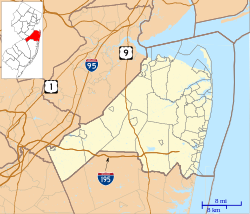Arburtus Cottage | |
 | |
| Location | 508 4th Avenue, Asbury Park, New Jersey |
|---|---|
| Coordinates | 40°13′25.1″N74°00′24.9″W / 40.223639°N 74.006917°W |
| Built | c. 1878 |
| Architectural style | Queen Anne |
| NRHP reference No. | 15000003 [1] |
| NJRHP No. | 5455 [2] |
| Significant dates | |
| Added to NRHP | August 18, 2015 |
| Designated NJRHP | December 16, 2014 |
The Arburtus Cottage, also known as the Stephen Crane House, is located at 508 4th Avenue in the city of Asbury Park in Monmouth County, New Jersey, United States. Built around 1878, the historic Queen Anne style seaside cottage was added to the National Register of Historic Places on August 18, 2015, for its significance in literature and social history. [1] The author, poet, and journalist Stephen Crane lived here from 1883 to 1892. [3] It is now the home of the Asbury Park Historical Society. [4]


